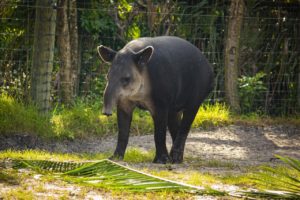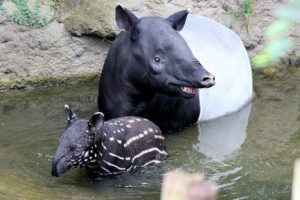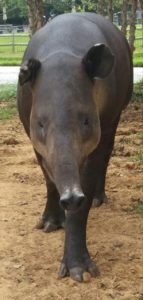This fascinating article unveils the secrets of the tapir, a unique creature that often sparks confusion due to its peculiar appearance. Though often mistaken for a pig with a trunk, the tapir actually belongs to the same evolutionary family as horses and rhinoceroses.
The tapir’s physique is a blend of intriguing features. Standing about the size of a donkey, it boasts a round body, short legs, and a stubby tail, reminiscent of a hippopotamus. But its most defining characteristic is its flexible snout, resembling an elephant’s trunk, although it is actually a combination of its upper lip and nose.
This versatile appendage serves multiple purposes for the tapir. It allows them to pluck leaves and fruit from trees, grab objects with dexterity, and even act as a snorkel while swimming. This aquatic prowess is a hallmark of the tapir, making them excellent swimmers who can even dive to feed on underwater plants.
While tapirs are not solitary creatures, they are considered somewhat social, often gathering in groups known as a “candle” for grazing. The article details the five distinct species of tapir, all sharing a similar size and inhabiting the forests of Central and South America, as well as Southeast Asia.
However, the article concludes with a sobering note: all tapir species are facing the threat of extinction due to hunting and habitat loss. This highlights the urgent need for conservation efforts to protect these unique and fascinating creatures.
The article provides a compelling introduction to the tapir, shedding light on its intriguing appearance, fascinating adaptations, and vulnerable status. It reminds us of the importance of understanding and protecting the diverse array of life that shares our planet.
Additional notes

Tapirs look something like pigs with trunks, but they are actually related to horses and rhinoceroses.
They are about the size of a donkey. They have round bodies, short legs and stubby tails, sort of like a hippo.
Their most distinctive feature is their snout, It is flexible like an elephant’s trunk. However, the tapir’s trunk is actually its upper lip and nose. Tapirs can grab things with their trunks, somewhat like an elephant. They use them to pluck leaves and fruit out of trees, When swimming, they can use it as a snorkel
They are excellent swimmers and can even dive to feed on aquatic plants.
Tapirs are somewhat social creatures. They graze together in groups called a candle
There are five species of tapir, and they are all relatively similar in size
Tapirs are found in the forests of Central and South America as well as Southeast Asia.
All tapir species are at-risk largely due to hunting and habitat loss.



 Pazionmedia.com Pazion Media l Latest News l Politics l Sports l Entertainment
Pazionmedia.com Pazion Media l Latest News l Politics l Sports l Entertainment



